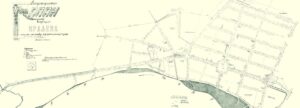Researchers of urban development in Serbia accepted the claim that the plans of Požega and Karanovac, whose main feature is the circular square, were made by Laza Zuban in 1832 and that they, along with the plan of Donji Milanovac with a square, from 1831, were the first steps of urbanization in Serbia. The realization of Zuban’s plan was started by Petar Lazarević Cukić in 1836. Turkish Karanovac was located in today’s Sijaće polje near the springs of Zlatarica and was burned by Karađorđe’s insurgents, who built Pljakin šanac, as a fortress around which a new Karanovac was built. The third location is the so-called Stara Čaršija, where the Church of Holy Trinity was built in the time of Prince Miloš in 1824 and Lord Vasa’s residence in 1831. Petar Lazarević Cukić “moved Karanovac to its current location and regulated it as we see it today”, that is, in the area between Pljakin šanac and Stara Čaršija, he realized the plan of Laza Zuban, with a circular square inscribed in the orthogonal plan of the streets. Kraljevo received the first names of streets and squares after the names of important personalities from the history of the Serbian people in the eighties of the 19th century, during the reign of King Milan Obrenović. The first four famous streets are Kralja Milana, Duhovna, Dobrička and Natalija. The names of streets and squares preserved in the copy of the Regulatory Plan of the town of Kraljevo from 1901 in their own way confirm the finalization of the long process of urban shaping that lasted from 1832 to 1901 and at the same time reflect the spirit of political conditions in Serbia at the end of the 19th century.
